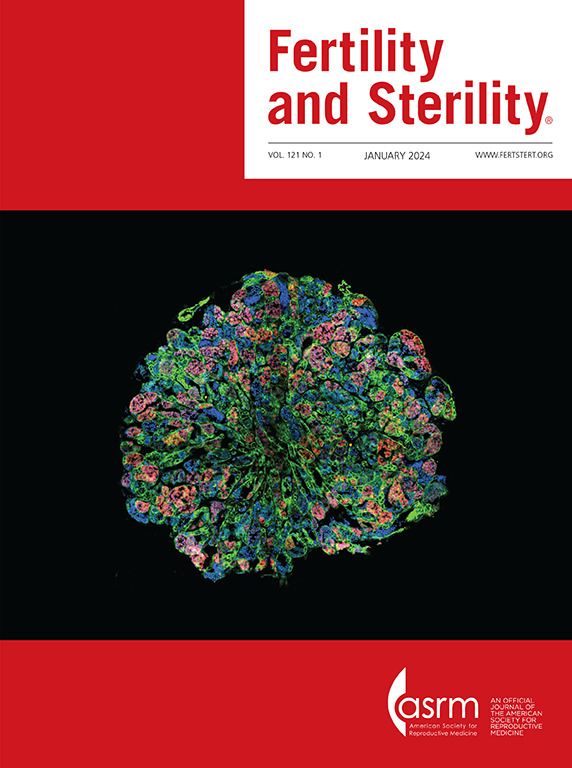育龄妇女月经特征与生育能力之间的相关性:系统回顾与荟萃分析。
IF 6.6
1区 医学
Q1 OBSTETRICS & GYNECOLOGY
引用次数: 0
摘要
重要性:月经是女性生殖健康的一项指标,对女性的生育率起着关键作用;然而,关于月经特征与生育率之间的流行病学证据仍存在争议:探讨育龄妇女月经特征与生育率之间的相关性:数据来源:我们使用PubMed、Embase、Web of Science和Cochrane图书馆进行了全面的文献检索,以确定截至2024年2月9日发表的研究文章:我们纳入了所有调查育龄妇女月经特征与怀孕率之间关系的研究。我们排除了涉及口服避孕药、应用辅助生殖技术以及有不孕症病史记录的个人或已知有不孕症病史的伴侣的研究:主要结果:临床妊娠和流产:这项荟萃分析由九项研究组成,共涉及 399 966 名女性,这些研究的证据质量较高,偏倚风险较低。与正常月经周期长度(2532 天)相比,月经周期短(32 天)对妇女怀孕的影响相对较小(OR=0.81,CI [0.65,1.01],I2=68%;OR=0.89,CI [0.75,1.06],I2=60%);然而,周期长度的变化可能会增加流产风险(RR=1.87,CI [1.11,3.15],I2=0%;RR=1.66,CI [1.07,2.57],I2=43%)。与月经初潮年龄正常(1214 岁)的女性相比,月经初潮年龄较晚(>14 岁)的女性怀孕的可能性较低(OR=0.92,CI [0.91,0.93],I2=0%);与月经出血持续时间正常(47 天)的女性相比,月经出血持续时间较短的女性怀孕的可能性较低(2=29%):月经周期过短和过长可能会增加女性自然流产的易感性,而月经初潮年龄过晚和月经出血持续时间过短似乎与育龄女性生育能力下降有关。本文章由计算机程序翻译,如有差异,请以英文原文为准。
The correlation between menstrual characteristics and fertility in women of reproductive age: a systematic review and meta-analysis
Importance
Menstruation serves as an indicator of women’s reproductive well-being and plays a pivotal role in their fertility; nevertheless, there remains an ongoing debate regarding the epidemiological evidence linking menstrual characteristics as well as fertility.
Objective
To explore the correlation between menstrual characteristics and fertility in women of reproductive age.
Data Sources
A comprehensive literature search was conducted using PubMed, Embase, Web of Science, and Cochrane libraries to identify research articles published up until February 9, 2024.
Study Selection and Synthesis
We included all studies in which the relationship between menstrual characteristics and pregnancy rates among women of reproductive age was investigated. We excluded studies involving the administration of oral contraceptives, the application of assisted reproductive technologies, and individuals with a documented history of infertility or partners with a known history of infertility.
Main Outcome Measure(s)
Clinical pregnancy and miscarriage.
Result(s)
This meta-analysis was composed of nine studies involving a total of 399,966 women, and the evidential quality derived from these studies was deemed to be high with a low risk of bias. Compared with a normal menstrual cycle length (25–32 days), the impact of a short (<25 days) or long (>32 days) menstrual cycle on a woman’s pregnancy was relatively insignificant ([odds ratio {OR}, 0.81; 95% confidence interval {CI}, 0.65–1.01; I2, 68%]; [OR, 0.89; 95% CI, 0.75–1.06; I2, 60%], respectively); however, a change in cycle length may increase the risk of miscarriage ([relative risk, 1.87; 95% CI, 1.11–3.15; I2, 0]; [relative risk, 1.66; 95% CI, 1.07, 2.57; I2, 43%], respectively). In comparison to women experiencing menarche at a typical age (12–14 years), those with a late age at menarche (>14 years) exhibited a decreased likelihood of pregnancy (OR, 0.92; 95% CI, 0.91–0.93; I2, 0%); and compared with women experiencing a normal duration of menstrual bleeding (4–7 days), those with a short duration of menstrual bleeding (<4 days) exhibited reduced fertility potential (OR, 0.86; 95% CI, 0.84–0.88; I2, 29%).
Conclusion(s)
Short and long menstrual cycle lengths may elevate women’s susceptibility to spontaneous abortion, whereas late age at menarche as well as short duration of menstrual bleeding appear to be linked to diminished fertility among women of reproductive age.
Clinical Trial Registration
PROSPERO CRD42023487458 (9 December 2023).
La correlación entre las características menstruales y la fertilidad en mujeres en edad reproductiva: una revisión sistemática y metaanálisis
Importancia
La menstruación sirve como indicador del bienestar reproductivo de las mujeres y desempeña un papel fundamental en su fertilidad; sin embargo, sigue existiendo un debate en curso sobre la evidencia epidemiológica que relaciona las características menstruales con la fertilidad.
Objetivo
Explorar la correlación entre las características menstruales y la fertilidad en mujeres en edad reproductiva.
Fuentes de datos
Se realizó una búsqueda bibliográfica exhaustiva en las Bases de datos: PubMed, Embase, Web of Science y Cochrane para identificar los artículos de investigación publicados hasta el 9 de febrero de 2024.
Selección y síntesis de los estudios
Se incluyeron todos los estudios en los que se investigó la relación entre las características menstruales y las tasas de embarazo en mujeres en edad reproductiva. Se excluyeron los estudios que implicaban la administración de anticonceptivos orales, la aplicación de tecnologías de reproducción asistida y las personas con antecedentes documentados de infertilidad o parejas con antecedentes conocidos de infertilidad.
Principales medidas de resultado
Embarazo clínico y aborto espontáneo.
Resultado(s)
Este metanálisis se compuso de nueve estudios con un total de 399.966 mujeres, y la calidad de la evidencia derivada de estos estudios se consideró alta con un bajo riesgo de sesgo. En comparación con la duración normal del ciclo menstrual (25–32 días), el impacto de un ciclo menstrual corto (<25 días) o largo (>32 días) en el embarazo de una mujer fue relativamente insignificante ([ {OR}, 0,81; intervalo de confianza del 95% {IC}, 0,65–1,01; I2 , 68%]; [OR, 0,89; IC 95 %, 0,75–1,06; I2 , 60%], respectivamente); sin embargo, un cambio en la duración del ciclo puede aumentar el riesgo de aborto espontáneo ([riesgo relativo, 1,87; IC 95 %, 1,11–3,15; I2 , 0]; [riesgo relativo, 1,66; IC 95%, 1,07, 2,57; I2 , 43%], respectivamente). En comparación con las mujeres que experimentaron la menarquia a una edad típica (12–14 años), aquellas con una edad tardía de la menarquia (>14 años) mostraron una menor probabilidad de embarazo (OR, 0,92; IC 95 %, 0,91–0,93; I2, 0%); y en comparación con las mujeres que experimentaron una duración normal del sangrado menstrual (4–7 días), aquellas con un sangrado menstrual de corta duración (<4 días) exhibieron un potencial de fertilidad reducido (OR, 0,86; IC 95 %, 0,84–0,88; I2, 29%).
Conclusión(es)
La duración de los ciclos menstruales cortos y largos puede elevar la susceptibilidad de las mujeres al aborto espontáneo, mientras que la edad tardía de la menarquia, así como la corta duración del sangrado menstrual, parecen estar relacionadas con la disminución de la fertilidad entre las mujeres en edad reproductiva.
求助全文
通过发布文献求助,成功后即可免费获取论文全文。
去求助
来源期刊

Fertility and sterility
医学-妇产科学
CiteScore
11.30
自引率
6.00%
发文量
1446
审稿时长
31 days
期刊介绍:
Fertility and Sterility® is an international journal for obstetricians, gynecologists, reproductive endocrinologists, urologists, basic scientists and others who treat and investigate problems of infertility and human reproductive disorders. The journal publishes juried original scientific articles in clinical and laboratory research relevant to reproductive endocrinology, urology, andrology, physiology, immunology, genetics, contraception, and menopause. Fertility and Sterility® encourages and supports meaningful basic and clinical research, and facilitates and promotes excellence in professional education, in the field of reproductive medicine.
 求助内容:
求助内容: 应助结果提醒方式:
应助结果提醒方式:


